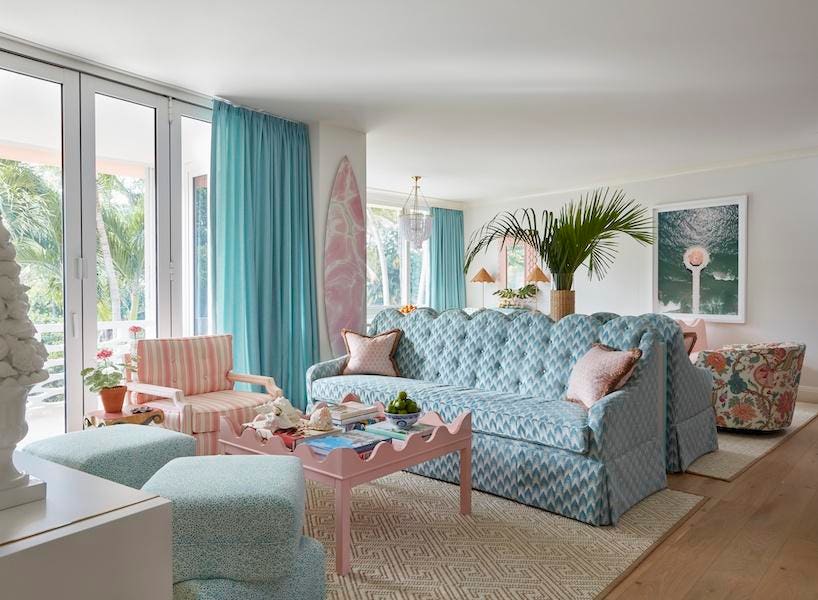Pink is a color most people associate with femininity, makeup, and Barbie, especially the Barbiecore decorating trend. But for many newly divorced women, it’s becoming the color of liberation—at least according to a viral Threads post by the co-founder of Fresh Starts Registry, Olivia Howell.
Just one sentence long, it has been viewed more than 395000 times: “No one tells you that starting over means crying at HomeGoods because you can finally buy the pink towels he hated.”
While it’s clear that this seemingly minor act of buying colorful towels is relatable, its meaning goes far beyond decorating trends.
Pink Flags
As the co-founder of Fresh Starts Registry (along with her sister, Genevieve Dreizen), Howell is an expert in starting over again. The world’s first and only divorce registry provides a way to register for anything and everything a newly-divorced person needs for a fresh start—whether it’s floral sheets or that expensive blender her ex-husband vetoed. There’s also a free directory of professionals, from home organizers to therapists, who can provide support during this often challenging time.
Howell tells me the reaction to her post was surprising. “It’s not that I was explicitly forbidden from buying pink towels or decorating with color, but looking back, I realize I compromised my design aesthetic to fit into the vision of what a good bride and a harmonious partner should be.”
She also realized she had been making compromises in her relationship and life that she really didn’t want to make for years, starting with her wedding registry. “I wanted to honor his preference for neutral tones, even though I’ve always been drawn to bold and bright colors,” she reveals. “So, we ended up with beige towels with our monogram on them—safe, classic, and admittedly…a bit drab. It wasn’t about strict rules; it was more of an unspoken understanding—pink just wasn’t part of our home’s palette.”
While beige towels are a minor compromise, they’re reflective of a larger issue. It’s not the towels, it’s the relationship.
Howell’s post has received 950 replies so far, many from women sharing their own stories of decorating. From painting their dining rooms pink to blush sofas and bright bedding, many commenters see the color as a symbol of liberation from bad relationships.
Threads user, Ashley Blom evevn humorously stated, “My bedroom after divorce looks like a preteen with an unlimited Five Below budget.” While she didn’t provide a photo, it’s fair to assume this statement is accurate.
No Permission Needed
While most of the Threads photos were DIYS, those with larger budgets are also embracing this color. According to interior designer Jennifer Beek Hunter, who is best known for her colorful and feminine, yet gorgeously sophisticated style, both divorcees and bachelorettes are increasingly requesting pink elements in their homes. From wallpaper to paint and bedding, it’s a color she works with quite often. “I think divorced women definitely like to decorate with pink as it is a way to express a newfound freedom and independence.”
Hunter explains much like Howell; her clients weren’t explicitly forbidden from using the color in the past, but rather, they were hesitant to even suggest it. “I do not think it was that they were not able to decorate with pink when married, but that they never thought to do it in fear that their husbands would say no. It is as if they didn’t even go there. Now, there is no one to answer to, no one to please, but themselves.”
Maybe Pink Isn’t The Problem—The Husband Is
Traditionally, pink has been a symbol of femininity, which can be a turn-off. “The resistance some men have toward pink furniture and decor is deeply rooted in cultural narratives that stretch back generations,” notes Howell. “This association begins before birth—nurseries are often color-coded pink for girls and blue for boys, setting the expectation that these colors signify gender. From an early age, many boys are taught—implicitly or explicitly—that pink is ‘girly,’ soft, and therefore less acceptable for them.”
Ultimately, the color represents what men shouldn’t be. So, having a pink home—even if it’s something their partner wants can potentially feel emasculating. “It’s almost like pink serves as a symbol of relinquishing some degree of control or masculinity in their own living space,” says Howell.
Oddly, while blue is considered a color for boys, it doesn’t hold equal weight as a symbol of masculinity. Most women don’t think twice about decorating with blue. It’s actually quite a popular choice. Yet some men view pink as a visible marker that they don’t have equal influence in the household’s aesthetic choices.
Could Pink Be A Symbol Of Something Deeper?
If a man is happy in his life and relationship, letting his wife buy a pink sofa or choose butterfly bedding shouldn’t require a second thought if it’s something that will bring her joy. “When we are unhappy in relationships, we use a lot of ways to show it, and sometimes it shows up as rebellion; if it’s a color a wife wants, the husband doesn’t, just because she does,” says Bonnie Scott, therapist and founder of Mindful Kindness Counseling. “And if we follow that line of reasoning, then it becomes symbolic of the ways he’s controlling the space, and by extension, his wife.”
So, when that relationship ends, out goes the man and the ugly black leather sofa she never really wanted in the first place. “Many women redecorate as a way to make a space feel reclaimed and fresh. It’s nice to be able to use items we like to create the vibe we want and express our style,” explains the therapist. “So when a woman has left a partner and is setting out into a new phase of life, it’s fun to go through the process of experimenting with style while not having to compromise with another person.”
Read the full article here

